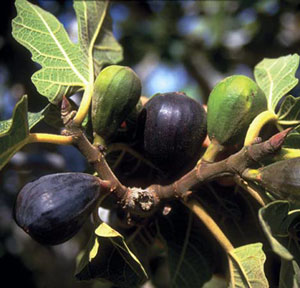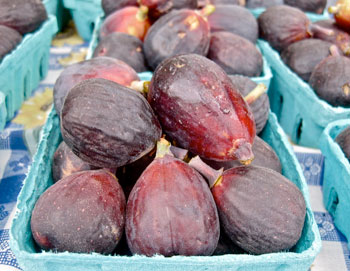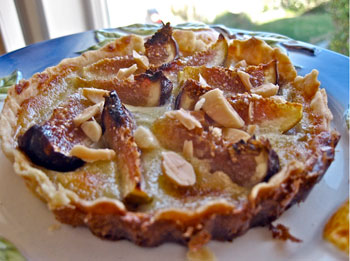 For those of us of a certain age, our first encounter with figs came not in life but in a movie theater when Oliver Reed used a fig, deftly cut open from the bottom, to help Alan Bates appreciate the pleasures of sensuality as he struggled with his attraction to Glenda Jackson in the 1969 classic, “Women in Love.” Watching Oliver Reed spread open that ripe fig was the height of eroticism to a young boy.
For those of us of a certain age, our first encounter with figs came not in life but in a movie theater when Oliver Reed used a fig, deftly cut open from the bottom, to help Alan Bates appreciate the pleasures of sensuality as he struggled with his attraction to Glenda Jackson in the 1969 classic, “Women in Love.” Watching Oliver Reed spread open that ripe fig was the height of eroticism to a young boy.
After the movie I rushed out and bought a basket of figs and marveled at their round fullness. The ones that were ripe had a heaviness that made my juvenile heart race with excitement. But to my young palate, used to simple fruits like apples and pears, figs were much too strong tasting.
I learned to appreciate figs when I lived in a house with a fig tree. I enjoyed watching the fruit slowly form, first as a small bulb attached to a twig, then bulging into a soft, round shape, expanding into a fullness that invited the touch.
In one of my most pleasurable, early food-moments I watched a fig ripen and picked it just as its nectar collected at the bottom. Bitting into its warm sweetness, I was hooked. My breakfast routine after that required only a cup of black coffee, a piece of dry toast, and a trip to the fig tree.
 Recently I visited a fresh produce store in our neighborhood. Since I buy my fruits and vegetables at farmers’ markets, nothing much tempted me, but as I was about to walk out empty-handed, a display near the check out counter caught my attention. A flat of 40 figs was priced at $3.99, usually the cost of a single basket. Seeing me staring at the display, a store clerk confided that the figs were so very ripe they had to be sold immediately, hence the extraordinary price. Indeed, some were bruised, others already attacked by mold but with the clerk’s permission, I replaced the bad figs with good ones and carried home a wonderful prize.
Recently I visited a fresh produce store in our neighborhood. Since I buy my fruits and vegetables at farmers’ markets, nothing much tempted me, but as I was about to walk out empty-handed, a display near the check out counter caught my attention. A flat of 40 figs was priced at $3.99, usually the cost of a single basket. Seeing me staring at the display, a store clerk confided that the figs were so very ripe they had to be sold immediately, hence the extraordinary price. Indeed, some were bruised, others already attacked by mold but with the clerk’s permission, I replaced the bad figs with good ones and carried home a wonderful prize.
But as anyone with a fruit-bearing tree knows, while the first appearance of fruit on a tree seems akin to a miracle, in time, as the season progresses and the small gathering of fruit turns into a seemingly unending torrent, that miracle can become a curse.
Now that I was home, what to do with all those figs?
 Given that I had so many figs, a rare occasion, I allowed myself a day of baking. I made, variously, a tart with a sweetened fig puree and quartered figs only, a second with a light sprinkling of raw sugar added, a third that included the puree, figs and sugar but allowed a drizzle of custard, and, another that had all of the above and added roasted, chopped almonds. All the tarts were good but I still felt unsatisfied, as if there was one more adjustment I needed to make.
Given that I had so many figs, a rare occasion, I allowed myself a day of baking. I made, variously, a tart with a sweetened fig puree and quartered figs only, a second with a light sprinkling of raw sugar added, a third that included the puree, figs and sugar but allowed a drizzle of custard, and, another that had all of the above and added roasted, chopped almonds. All the tarts were good but I still felt unsatisfied, as if there was one more adjustment I needed to make.
In the past I had experimented with crystallized ginger in pie crusts. Finely ground, the ginger and its sugar are so thoroughly spread throughout the crust, their flavors influence but do not predominate the flavor profile of the dessert.
With that last addition, I felt I had a winner. The crystallized ginger added a sense of heat, contrasting perfectly with the sensual figs. Served at a dinner party, my choices were confirmed. The fig tart was approvingly declared “not too sweet, so full of flavor.”
A Fig Tart with Custard, Crystallized Ginger, and Almonds
A pâte brisée dough, thinly rolled out, creates a flaky starting point for the layers of flavors in the tart. The fig confit has a rich huskiness. A simple custard binds those flavors together. The roasted almonds complete the contrasts of flavor and texture. All four ingredients can be prepared days ahead so the tart can be easily assembled on the day.
Makes a 9” tart or three or four 3” tartlets
Fig Confit
Ingredients:
4 of the ripest figs, washed, quartered lengthwise
1 teaspoon raw sugar
1 tablespoon water
Directions:
Scrape off and finely chop the inner part of the figs. Discard the skins. In a small saucepan mix together the fig puree, sugar, and water. Heat over a medium flame. Simmer and stir frequently for 5 minutes. Set aside to cool. Will keep in a refrigerated, sealed container for several days.
Custard
Custard is easier to make than you might think. This recipe is simplicity itself. The uncooked custard can be refrigerated for up to 2 days.
Ingredients:
1 large farmers’ market fresh egg
¼ cup white sugar
½ cup heavy cream (not whipping cream) Trader Joe’s sells the only cream I can find without preservatives
Directions:
Beat together the egg and sugar. Add the cream and blend well.
Roasted Almonds:
¼ cup whole, raw almonds
Roast the almonds in a 350 degree oven for 10 minutes, shaking the pan every so often to prevent burning. Remove, let cool, and roughly chop. The roasted almonds can be kept in a sealed jar for several weeks.
The Dough:
I prefer a thin crust, because I want the figs, custard, and almonds to predominate, but if you like a more substantial crust, double the recipe.
Ingredients:
1 tablespoon or 3 pieces of crystallized ginger
1 ¼ cups all-purpose white flour (I like King Arthur Flour)
½ teaspoon sea salt, finely ground
1 teaspoon white or raw sugar
1 stick or ½ cup sweet butter, kept cold, finely chopped
3 tablespoons ice cold water
Directions:
Use a chef’s knife to chop up the crystallized ginger as much as you can before further grinding in a food processor with a metal blade. Don’t worry if you’re left with large pieces. Add the flour, sea salt, sugar, and butter. Pulse for 30 seconds until well combined.
With the food processor on, slowly add the ice-cold water in a steady stream. If the flour accumulates on the sides of the processor, shake it loose. Add enough water so the flour gets crumbly and sticks together.
Lightly flour a work surface and your hands. If you are making smaller tarts, divide the dough accordingly. Gently work the dough into a flattened disk about 5”-6” in circumference for the large tart, 2”-3” for the small, turning it so all sides are dusted with flour. Wrap in plastic and refrigerate for at least 1 hour or overnight.
Brush melted sweet butter on the tart pan. Place in the freezer for at least 30 minutes or overnight. This will guarantee that the dough will not stick to the pan.
Assembling the Tart
To keep the tart as fresh as possible, bake just before serving.
Ingredients 2 baskets ripe figs, washed
Custard
Fig confit
Roasted almonds
Tart dough
Directions
Before rolling out the dough, let it sit on the counter 30 minutes. Preheat the oven to 400 degrees.
Again, lightly flour a work surface. Roll out the dough evenly, starting in the middle and working to the outer edges, keeping the round shape as much as possible. Create a circle of dough 2”-3” larger than the circumference of the tart pan so there’s enough to line the sides.
Take the tart pan out of the freezer. Use the rolling pin to transfer the dough onto the pan. Start on one edge, lifting the dough onto the rolling pin, moving forward until the dough has wrapped around the rolling pin. Gently place the dough on the tart pan, being careful to press the dough against the sides of the pan. Use a paring knife to gently cut off the excess dough.
Use pieces of the excess dough to fill any holes or close any tears. Tarts are very forgiving.
Using the paring knife, poke holes every few inches on the bottom of the tart to release steam during baking. Pour pastry weights or uncooked rice to cover the dough. Bake 10-15 minutes in the preheated oven or until the crust is lightly browned. Cool on a rack. Carefully remove the pastry weights or rice.
Reduce the oven temperature to 350 degrees F.
Using a pastry brush, spread the fig confit evenly over the bottom as well as the sides of the crust. Cut off and discard the stems from the figs and quarter them lengthwise. Lay the figs on the bottom of the tart, cut side up, in a decorative way, which usually means placing them in circles within circles. Sprinkle with 1 tablespoon raw sugar. Place the tart on a baking tray and put in the oven. Bake 20 minutes.
Remove the tart from the oven. Drizzle custard over the figs. Sprinkle with roasted almonds. Return to the oven for another 30 minutes.
Check to see that the custard has set. Be careful not to burn the figs. Remove the tart and let cool on a rack.
Serve warm, dusted with powdered sugar and with a bowl of vanilla ice cream or freshly whipped cream.
David Latt is an Emmy-award winning television producer who turns to cooking to alleviate stress. He shares his experiences with food and his favorite recipes on his blog Men Who Like To Cook.

